Jessica Brilli
A preview of Jessica Brilli’s work, which keeps getting better and better, on view at Kobalt Gallery in August.
the painting life
A preview of Jessica Brilli’s work, which keeps getting better and better, on view at Kobalt Gallery in August.
There’s a little more than a week left to see Among Untrodden Ways at Oxford Gallery, and it’s well worth the time to get there before it closes. Sean Witucki, Charles Houseman, and Ken Townsend are all working in the same stylistic neighborhood, but each of them has a distinctly individual vision.
Of all the work from Witucki in the show, the standout is a small oil, only a foot in height, Wolf Creek After the Rain. The way he renders the water of the creek purling over the shallow ledge of laminated shale so common in Western New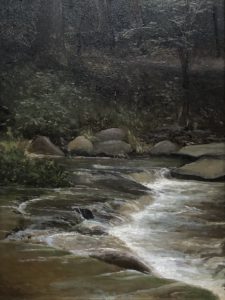 York is remarkable. Anyone who has hiked the Finger Lakes will recognize that hardened prehistoric mudstone, once the bottom of a sea, under such a thin layer of fresh water. The color of the water, from ochre to olive and then to a gray/greenish blue where it recedes to the far rocky bank, is amazing. The little fringe of foam, harmless whitewater to a wader, beckons to the viewer, but it’s what’s below that remains enticingly visible, an inviting but risky submerged surface, seen through ripples and reflections of the sky. He manages to capture that sense of being able to look into the water down to the slippery face of the creek bed—there’s more trouble here than the shallow depth would suggest. One wrong step and you’re on your back. The woods beyond are done with Corot-like flicks of the brush on soft masses of color. The image conveys a rapt, luxuriant pleasure in the paradoxical stillness, the restfulness, of water that never stops changing but always seems the same.
York is remarkable. Anyone who has hiked the Finger Lakes will recognize that hardened prehistoric mudstone, once the bottom of a sea, under such a thin layer of fresh water. The color of the water, from ochre to olive and then to a gray/greenish blue where it recedes to the far rocky bank, is amazing. The little fringe of foam, harmless whitewater to a wader, beckons to the viewer, but it’s what’s below that remains enticingly visible, an inviting but risky submerged surface, seen through ripples and reflections of the sky. He manages to capture that sense of being able to look into the water down to the slippery face of the creek bed—there’s more trouble here than the shallow depth would suggest. One wrong step and you’re on your back. The woods beyond are done with Corot-like flicks of the brush on soft masses of color. The image conveys a rapt, luxuriant pleasure in the paradoxical stillness, the restfulness, of water that never stops changing but always seems the same.
Charles Houseman has contributed more than a dozen of his newest paintings to the show, and I reacted most strongly to the most elemental, his vision of the Maine Coast, Great Head at Low Tide, where rock, sky, trees and tidal pool compose a scene that—like Townsend’s shale—could have remained largely the same for a hundred thousand years. It perfectly captures the way the Maine coast seems assembled—or rather dropped into place by a receding glacier—to repel anyone who isn’t standing on dry land, while still inviting you through a jagged gauntlet of stone with its hazy beauty. One of his smaller paintings, Newton Farm, was a minimalist composition with a small strip of land beneath a blue void, an apophatic affirmation of energy through the absence of everything inessential, both pictorially and for anyone actually standing out in that open field, taking it all in.
The revelation for me in this show is Ken Townsend’s assured versatility, where nearly every painting looks utterly natural while being carefully, masterfully designed. It’s his first appearance at Oxford and an auspicious one. Most of his paintings can be broken down into four areas of comparatively uniform value that lock together like a simple puzzle, with all the detail rendered as variations within that particular value—darkest, second darkest, second lightest and lightest. The way he gives each of these areas a clearly defined contour, compositionally, makes the paintings so visually powerful. It also enables him to emphasize and augment the color in each of these areas almost as an abstractionist would. He could push this even more than he does, but when he allows himself some rich hues, the colors are 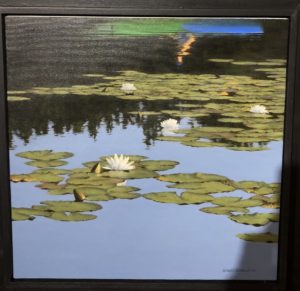 beautifully chosen, deeply felt. This is readily apparent in work like Gardner’s Road and Mendon Ponds, an overhead glimpse of water lilies, with one small white blossom serving as the tiny, lightest section. Yet a second painting of probably those same water lilies, Dar Reflected, is a perfect example of how Townsend is able to lay down areas of vibrant color by emphasizing and unifying those four areas of value and working within them as a structure for the image. All the viewer sees is a flat stretch of violet water, reflecting the sky, throughout most of the lower half of the painting, broken up by a cluster of lilies with one blossom, and then in the upper half of the canvas, the reflection of the dark woods and at the top, what appears to be the rippled reflection of a two-toned kayak with a slash of pink for the paddler. Keeping out of view what would have been the subject of the whole painting for most painters (Eakins, for example) is what enlivens the entire scene. The brilliant blue and green of that reflection draw your eye and then leave it wanting, hinting at what’s almost visible, so that what you actually see feels more like a memory or a dream of something even more alive than what’s available to the eye.
beautifully chosen, deeply felt. This is readily apparent in work like Gardner’s Road and Mendon Ponds, an overhead glimpse of water lilies, with one small white blossom serving as the tiny, lightest section. Yet a second painting of probably those same water lilies, Dar Reflected, is a perfect example of how Townsend is able to lay down areas of vibrant color by emphasizing and unifying those four areas of value and working within them as a structure for the image. All the viewer sees is a flat stretch of violet water, reflecting the sky, throughout most of the lower half of the painting, broken up by a cluster of lilies with one blossom, and then in the upper half of the canvas, the reflection of the dark woods and at the top, what appears to be the rippled reflection of a two-toned kayak with a slash of pink for the paddler. Keeping out of view what would have been the subject of the whole painting for most painters (Eakins, for example) is what enlivens the entire scene. The brilliant blue and green of that reflection draw your eye and then leave it wanting, hinting at what’s almost visible, so that what you actually see feels more like a memory or a dream of something even more alive than what’s available to the eye.
The Townsend painting that knocked me out, though, was a very small square one, Roadside I, executed with palette knife. The technique, though rougher and more approximate than any of the paintings done with brushes, creates a snowy embankment almost more visually convincing than anything else in the show—with a tremendous sense of clarity. Again, he’s broken down what he sees into continuous areas of value, the darkest, a line of trees on the horizon, then the brightest strip, in the patchy snow just beneath it and then, above and blow these two tiers of color, the cerulean sky and a violet reflection of the sky in the snowbank, sharing almost the same value, with a triangle of road at the bottom, the second-darkest region of the image. He captures everything perfectly, the low sunlight scudding almost horizontally across the embankment, the becalmed sky, and the purple shadows that look scraped into the soil and driven over by a plow or a truck, yet without any indication of exact detail in the thickly scumbled paint from under his knife. The eye sees what it expects to see though it isn’t really there. He works into the image not just the purple of the snow and the classic blue of the sky but a little strip of orangish growth along the tree line, a color also breaking through the snow in the foreground, that makes the other colors sing a little more distinctly. It’s a perfect painting, hopefully hinting of more to come.
(Note: for fun, see if you can find the one Witucki painting in the show that bears the same title as an old Pearl Jam song.)
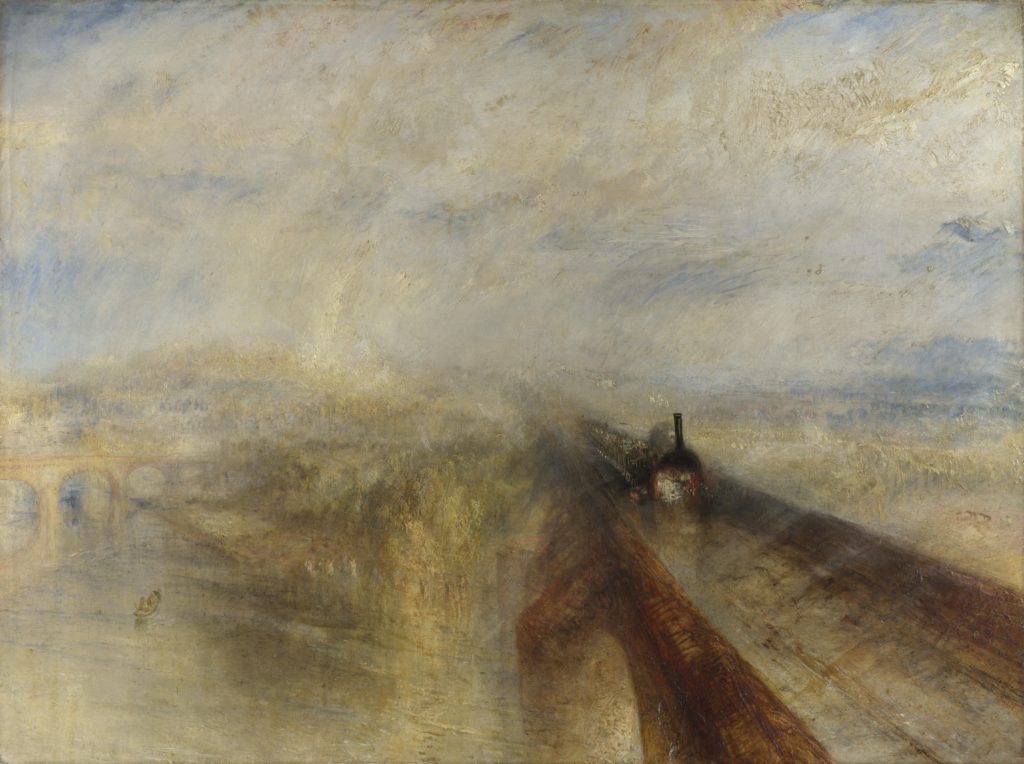
From My Struggle, Karl Ove Knausgaard’s phenomenological angle on Turner’s painting:
. . . the eye that puts aside all it knows, that puts aside all preexisting insight, is the eye that can see the world anew, as if it were emerging before it for the very first time. Turner was interested in the relationship between the inconstant and the immutable, the solid and the fluid, and in that way the train becomes an expression not of anything else, one of the many categories into which it might be placed to do with modernity, industrialism, civilization, and the man-made, but only of what it is in itself, in pure physical terms, an enormous iron object proceeding along an iron track, almost obliterated by the snow, which would obliterate almost any other object in the same way: a sailing ship, a horse-drawn carriage, a funeral procession, a bear.
—Karl Ove Knausgaard, My Struggle, Volume 6
The painting shows how dwarfed this massive iron horse appears in the context of a nature overpowering and sublime. Our view of nature now is both the same and the opposite: in the “anthropocene,” we constantly tell ourselves that we are changing everything around us, spoiling it and twisting it into a state of imbalance and disorder, and we makers of engines are going to incite nature to violent storms and deadly droughts and massive, hostile phenomena akin to what Turner was depicting. The difference is that now we think our little engines, our technological and chemical footprints, cause the storm that envelopes them and threatens their and our disappearance. Now the engine in the painting, as it were, creates what dwarfs and erases it from view–we are the storm. As usual with human beings, it’s all about us.
Knausgaard glosses over Turner’s awe and passion for nature’s beauty and power, no matter how hostile it becomes to human life, his Romantic devotion to nature as a new sort of God, a source of mystery, if not meaning. He’s right that Turner wasn’t trying to illustrate an idea, but convey through perception and intuition the relationship between human life and a larger, implacable world–the way Chinese scroll paintings juxtaposed tiny human figures against beautiful, craggy mountains, putting us into proper perspective within the whole. (It’s nice that the Sung Dynasty had no locomotives to include.) Man isn’t the measure of all things, in those paintings, except as a unit for judging the scale of a world infinitely more extensive than the human body and human concerns.
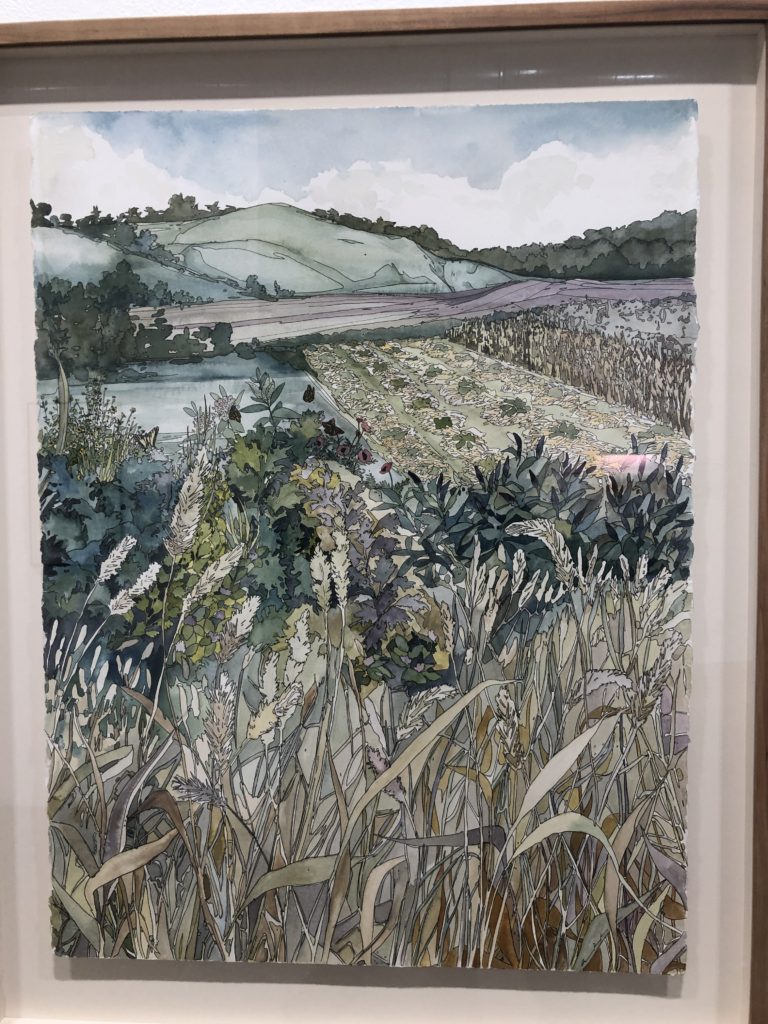
Andrea Durfee at ROCO
When I was growing up, in both East St. Louis and then in Idaho, my family lived at the edge of undeveloped land. These havens for my imagination weren’t protected, just overlooked or privately owned—undisturbed stretches of wildlife and undergrowth, a mix of grassy slopes, streams, and wooded paths. In a suburb at the edge of East St. Louis, it was a small copse at the base of the hill behind our little Cape Cod, and in Idaho, from our home sitting at the rim of the bench—just above the Boise Valley—I could walk to the edge of our back yard and look down at a fenced pasture with horses and, alongside it, the only human development within a convenient walking distance from the base of the slope, a sawmill. (We had some dangerous forbidden fun bounding across those floating logs.) My friends and my brother and I would spend hours in those spaces, only dimly aware of the smells, the soft feel of the earth, the birds and insects—yet all of it was imprinting itself on my mind whole, planting in me the desire to grow things as an adult and to get outside whenever possible. In those little overlooked tracts of wildness, I felt in touch with myself and the world in a way that I couldn’t in school or inside our home, in front of a television, the only screen that existed back then.
There’s a surplus of artwork on view in Rochester right now devoted, more or less, to the symmetry between human nature and the natural world. (Thou art that, the ancient Hindu philosophers would say.) In a fortunate coincidence, while Oxford Gallery is showing the work of three masterful landscape painters, Rochester Contemporary Art Center has assembled a themed show, Landscapes and the Unbuilt, that celebrates the slightly paradoxical effort that we human beings are making to keep from spoiling places like the ones that helped shape me as a kid. We’re intervening to prevent ourselves from, well, intervening. For the RoCo show, a group of artists took as their subject a particular parcel of land under the protection of the Genesee Land Trust, and they created one or more works to capture the spirit of the place. The work is all marvelous, especially grouped together in a way that amplifies each individual effort—and some of it represents the best work I’ve yet seen from these particular artists. The terms of the show may have brought out new dimensions in their work by forcing some of them to pay attention to the particulars of a specific place.
I responded most intensely to what I saw just inside the entrance to the East Avenue membership gallery. There’s an intricacy and density in Andrea Durfee’s paintings and Bill Stephens’s drawings that makes it hard to get any deeper into the exhibition, there’s so much to see in just one or two of these pieces up front. In the work of both, the task of having to convey an actual, particular place—to sift through myriad impressions of a specific location and nurture a companionship with that landscape—produced excellent results. I’ve always liked Durfee’s work, but the clarity and particularity of her vision is amazing in her three largest paintings of Full Lotus Farm in Arcadia, NY. It feels like a new benchmark for her. She uses flat areas of color outlined with spiderweb-thin lines, vaguely reminiscent of stained glass. Her technique echoes the outlines of cloisonnism and some of the Nabis, yet her paintings have a different effect on the viewer—they draw you deep into the scene she depicts, forgetful of the painted surface, though they aren’t conventionally realistic. In each one, she conceals a nude female figure—her avatar, maybe—merged with the landscape yet emerging like bedrock pushed up from beneath permafrost. Continue reading ‘Visions of the unbuilt’
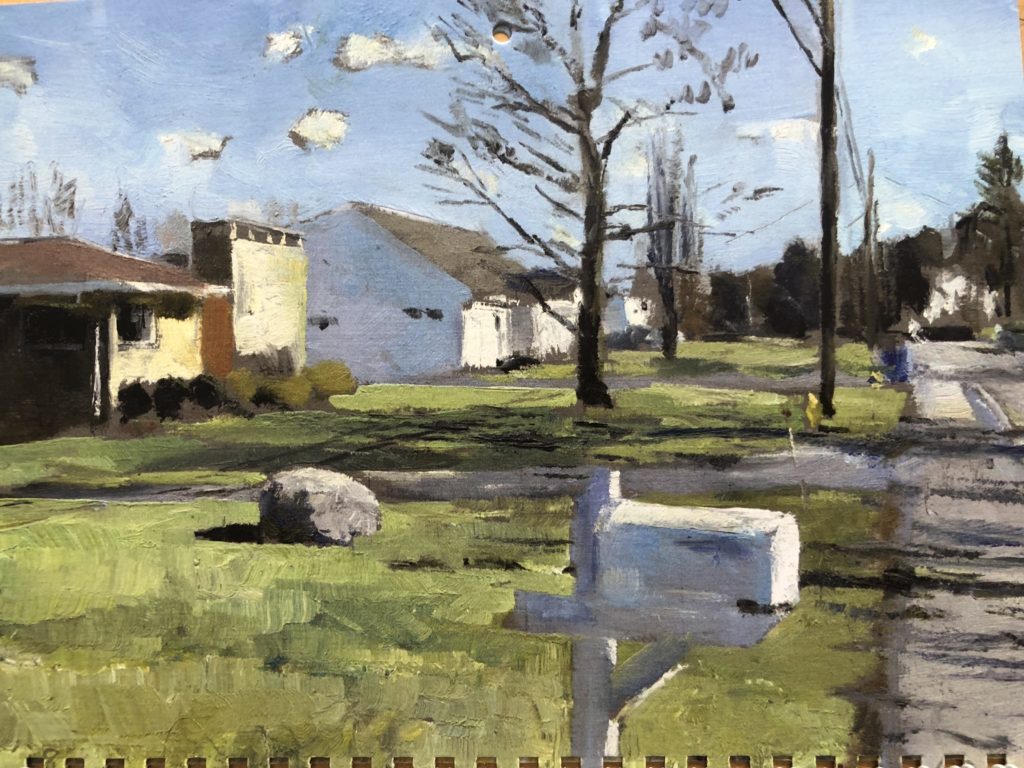
My next post will be about the current, marvelous exhibition at ROCO: a group of artists showing work that celebrates a particular place worthy of preservation in this region. But first I wanted to catch up on Jim Mott, whose own work would have found a place into that show if only he hadn’t had a solo exhibition there just a short while ago. Jim does, all of the time, what the artists now on view at ROCO did simply for the curatorial purposes of the exhibition: to pick a place, sometimes at random, and depict whatever he sees as equally worthy of consideration, no matter what it is.
Mott came by for a cup of tea recently and talked about a variety of things and rather than take time to rework our conversation into a regular post, I’ll just pass along the conversation, as I’ve done before, which should be of interest to his fans. I have high hopes for the residency he’s seeking at the University of Michigan. I think his proposal should get some serious interest, but the ordinariness of his work almost puts it outside the mainstream now—but he has an interesting angle on how he might present his project, which he discusses. He stayed long enough to touch on a lot of different things, yet left in time to get in some cross-country skiing at Mendon Ponds Park before it got dark:
Jim: I’ve been reading this longish book. Richard Powers? A friend of mine from Nature Conservancy gave me this novel of his about trees. The first half is brilliant but the second is good but not as exciting. He takes nine different characters, odd people who are moved by trees toward something and then he goes to a showdown in the Northwest. It’s intensely poetic and full of information. He got a genius award.
That always helps.
Jim: He gets all ecstatic about trees. I didn’t loan you Julian Bell did I?
I don’t think so. Are you still communicating with him?
Jim: Yeah, I have an open invitation if I ever get to England.
<I mention that I’m reading the last volume of My Struggle, which includes a long essay about Hitler and how Knausgaard thinks the modern era has de-individualized society and has cut people off from nature so that

This is spot on. From an interview with Robert Ryman:
RYMAN: I came from music. And I think that the type of music I was involved with—jazz, bebop—had an influence on my approach to painting. We played tunes. No one uses the term anymore. It’s all songs now, telling stories—very similar to representational painting, where you tell a story with paint and symbols. But bebop is swing, a more advanced development of swing. It’s like Bach. You have a chord structure, and you can develop that in many ways. You can play written compositions and improvise off of those. So, you learn your instrument, and then you play within a structure. It seemed logical to begin painting that way. I wasn’t interested in painting a narrative or telling a story with a painting. Right from the beginning, I felt that I could do that if I wanted to, but that it wouldn’t be of much interest to me. Music is an abstract medium, and I thought painting should also just be what it’s about and not about other things—not about stories or symbolism.
ART21: You don’t think of meaning?
RYMAN: There is a lot of meaning, but not what we usually think of as meaning. It’s similar to the meaning of listening to a symphony. You don’t know the meaning, and you can’t explain it to anyone else who didn’t hear it. The painting has to be seen. But there is no meaning outside of what it is.
ART21: So, meaning is closer to an emotional reaction?
RYMAN: I think that’s the real purpose of painting: to give pleasure. I mean, that’s really the main thing that it’s about. There can be the story; there can be a lot of history behind it. But you don’t have to know all of those things to receive pleasure from a painting. It’s like listening to music; you don’t have to know the score of a symphony in order to appreciate the symphony. You can just listen to the sounds.
ART21: How does your work fit into the contemporary art world?
RYMAN: I don’t think of myself as being part of anything. I don’t get involved with art. I mean, I’m involved with painting, but I just look at it as solving problems and working on the visual experience. I’m not involved with any kind of art movement, and I’m not a scholar. I’m not a historian, and I don’t want to get into that kind of thing because it would interfere with my approach. So, it’s better that I not think of that. (LAUGHS)
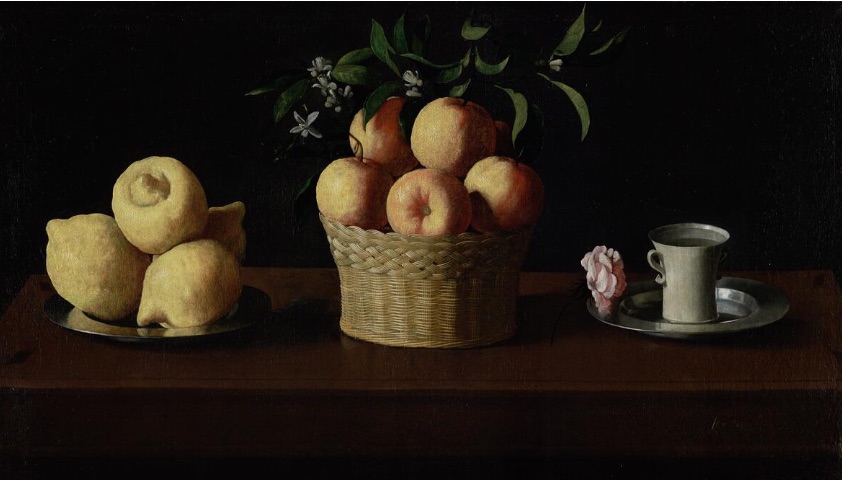
Zurburan’s fascinating, austere Still Life with Citrons, Oranges and a Rose hangs directly opposite the entrance of its period room so that it commands your attention as soon as it comes into view at the Norton Simon Museum. When I saw it a few weeks ago during our visit to the museum in Pasadena, I immediately recognized the work from its visit to The Frick a decade ago. What I actually remembered was Peter Schjeldahl’s review of the show and his justly ecstatic paean to this particular painting—similar to his raptures over Morandi in another essay. It’s simple, spare, and as perfectly balanced and restful as a Matisse, but also full of mysterious grandeur, in an almost ironic way, since it’s a depiction of the most commonplace things. It’s a surprisingly large painting by traditional still life standards, close to four feet wide, so that the depicted objects are larger than their actual size. The layers of Catholic symbolism—the objects standing both for the Holy Trinity and the Virgin Mary—has little resonance now and yet the painting’s power and subdued beauty hasn’t diminished. Its simplicity feels as integral as ever, as if it embodies some kind of alternate mathematical axiom—five + seven + three = one. Stripped of its religious symbolism, it continues to shine with its intended spirit, as if Zurburan’s religion was merely a way of climbing a ladder, as an artist, to quotidian serenity not limited to its theological expression.
The ideas have fallen away leaving the perceptual power of the image to keep working on the viewer and marvelously urging the same orientation toward the world as the ecclesiastical one. The lesson has faded, but its wisdom remains: humility, self-abnegation, attention to the abundance of ordinary experience, and gratitude for any glimpse of ordinary goodness and truth and beauty. Both artist and viewer marvel at the generous luxury of the earth’s simple gifts, its fruit and flowers. These subjects still look like offerings on an altar but at the same time seem to be just the opposite: not sacrifices, but gifts going in reverse, from a greater to a lesser power—from one who can make a lemon to one who can make a picture of one—offered to whomever stands before them as sustenance for either body or spirit.
In other words, even without all the intellectual trappings that gave Zuburan a pretext for making this painting, they pass along the same monk-like devotional intensity—in the assiduously achieved formal qualities of the painting, the long hours of solitude in the studio—without consideration of his religious justification for painting them. They stand as an example of how the greatest art embodies a life that spills up over the lip of every meaning and purpose meant to contain it—and meant for it to contain—conveying a quality of attention that operates as a moral and spiritual corrective in and of itself. A great still life conveys psychological qualities that have moral consequences—silence and calm. The painting stands as one of the supreme justifications for the still life genre—not nearly as congenial and charming as Chardin, but just as magical as the French master’s best. The humblest and most commonplace objects, simply by reflecting light a certain way, seating themselves naturally in their space, bearing the pull of gravity in their own particular ways, can convey the quiddity of life itself, long before the mind has time to go to work breaking down what it sees into what it ostensibly means and, in the process, gets further and further from the actual work—and life—itself.
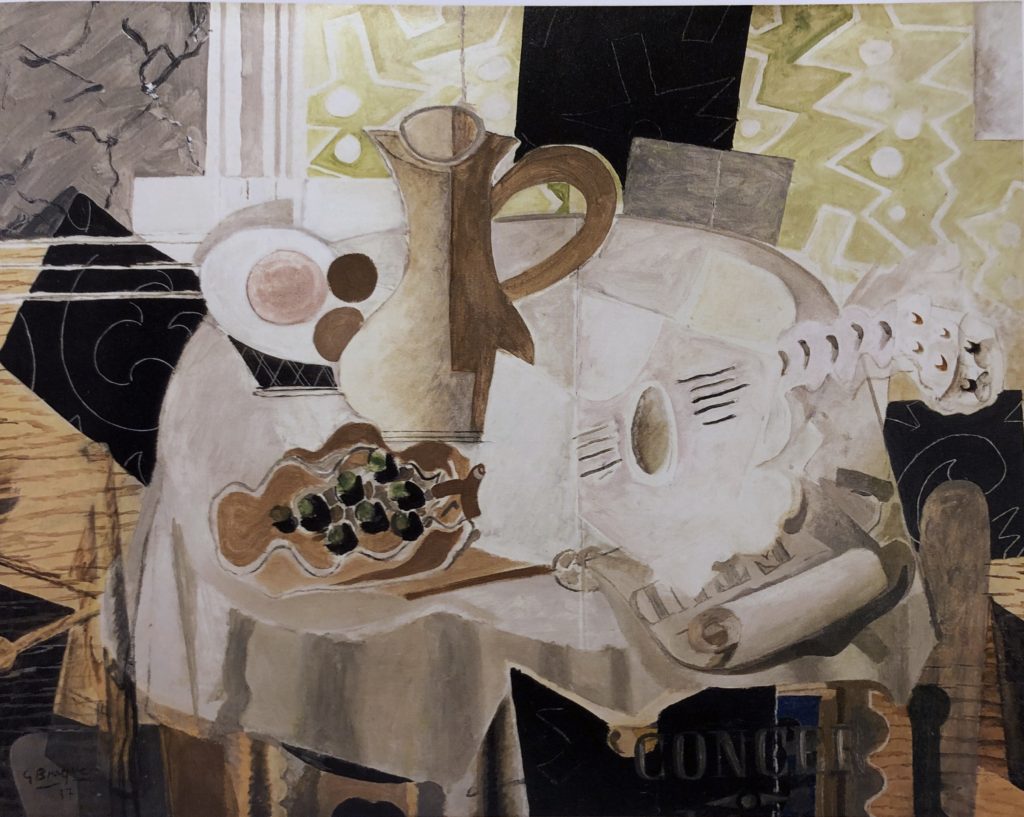
On my visit to LACMA last month, I was delighted most by the work in two particular areas of the museum: Fantasies and Fairy Tales, a themed exhibition of arresting prints and the small wing devoted to the Janice and Henry Lazarof Collection. The latter had the feel of those private collections converted into museums–the Frick, the Phillips–where the taste of the collectors is tantamount to a class on how art should be made. Nearly everything in the Lazarof Collection begged to be photographed, but when I tried to take a shot of the Braque above, the guard hurried over and chastised me, which was a surprise, because the wing appeared to be a permanent installation of work–a way of sharing the vision of two insightful collectors with the public–not a temporary exhibition, which seems to be the only shows that prohibit photography now in an effort to increase catalog sales. I asked, therefore, if there was a book available, and he directed me to the shop where it was on sale and for a discount. It was a fortuitous purchase because it includes a long essay on Picasso, so prominently featured in this collection, that turned out to be an indispensable aid to the thinking I’ve been doing, since my visit to Los Angeles, about one particular Picasso print I saw elsewhere at LACMA–it changed my understanding about that painter whose fame and position in the history of 20th century painting has always, for me, eclipsed the aspects of his work that have turned out to be most powerful and intriguing.
So I purchased a book simply to bring home an image of this particular still life by Braque, which was done toward the end of his most fertile period, from his move toward synthetic Cubism through the more and more idiosyncratic interpretations of pedestal tables, the “gueridons,” his most personal motif, especially with a guitar on board. It preoccupied him for at least twenty years; the most representative and familiar example of this series is The Gueridon at the Phillips. What’s astonishing about this work, for me, is that everything in the paintings from this period–with a few exceptions–seems to have been invented perfectly, naturally, as if Braque were proceeding like a scrupulous realist, where you know the work is great because the proper marks are the ones that most faithfully reproduce exactly what’s seen. The rules are obvious and simple. Here, none of that is the case, there is no common sense guideline for what makes a Braque so manifestly perfect–everything he sees or imagines is flattened into an essentially arbitrary pattern, and yet though every shape and line and color seems the outcome of improvisation, the final result looks inevitable, almost immutable and right, but also deeply felt in a way that seems in a class of its own next to all the other work that sprang from the Cubist movement. How a painter achieves this is the great mystery–on a par with the question of how Vermeer enabled a fleeting moment in an average day to look eternal. Braque’s own enigmatic journals only deepen the mystery and suggest that his path, once he broke with Picasso, took him more and more deeply into the region he entered via synthetic Cubism–a long, meditative and assiduous creative exploration during which Braque rightly felt infallible without ever letting his ego know what he was up to. He’d reached the artistic equivalent of a state of grace:
On this painting, from Envisioning Modernism, p. 62:
The viewer is thus forced to focus on the tenuous relationship between the still life and its environs, demonstrating what Braque called his “great discovery”: “Objects don’t exist for me except in so far as a rapport exists between them or between them and myself. When one attains this harmony one reaches a sort of intellectual nonexistence–what I can only describe as a state of peace–which makes everything possible and right. Life then becomes a perpetual revelation. That is true poetry.”
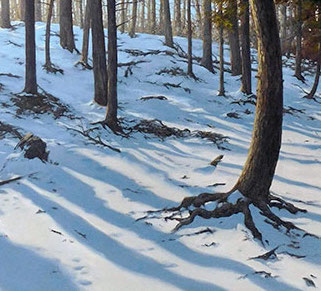
I’ve been reading, with greater and lesser pleasure, Karl Ove Knausgaard’s My Struggle, which–throughout the series of fictionalized memoirs–has repeated references to Romanticism, especially in painting. In the narrative, he’s regularly moved by images that convey the implacability of nature–and these moments, not of epiphany, but of emotional release, baffle him because the author has no way of making sense of his deep response to nature through these paintings, in contrast to his almost Beckett-like exhaustion with the daily life he so tediously represents in thousands of pages of prose. My response to the series of books is similar to my reaction when I look at artwork created in devotion to an invariable idea–in other words, a fair amount of work done over the past 150 years–once you grasp the idea, if it’s merely the illustration of an idea, why keep reading or looking? What’s fascinated me about Knausgaard is his deep ambivalence about modernism and the way it has set ordinary human emotions aside in favor of general artistic principles (though his own artistic principles seem, in the course of the work, to be destroying his own family so that maybe has more in common than he thinks with the modernism he distrusts). Hence, his retreat, emotionally, to Romanticism. Yet, in the final volume he seems to see his florid outpouring of feeling in reaction to certain poetry and painting as delusional, or at least negligible–leaving the reader with a vision of his creative work as a pointless exercise in obsessive attention to his own life, out of a conviction that life is essentially meaningless. Not exactly where I had though he might be going.
Three artists on view now at Oxford Gallery are equally drawn to the beauty and grandeur of nature–Ken Townsend, Charles Houseman, and Sean Wituck–and don’t quite distrust their passion the way Knausgaard does. And there’s an appreciative realism involved here, a friendly humility in the face of nature, that seems more contemporary than the era evoked by the quote from Wordsworth Jim Hall has used for the show’s title. Their work hints back to the Romantic love for nature, but not in a way that evokes the Hudson River School, nor the sublime of Edwin Burke or Kant, where nature is great beyond comprehension. Turner’s storms are nowhere to be found here. Nature is beautiful in their paintings, and in some cases, as indifferent to human comfort and scale as it is in the Romantics, but it’s also still, inviting, and serene–a setting for human purposes, on its own terms. The painting that most interests me is what appears to be a diptych depicting a spot on the coast of Maine, at Acadia National Park by Houseman–enormous rocks, typical of Maine’s fractal coast line of glacial rock. The massive boulders at the center are surrounded by tidal pools covered with a thin layer of autumn leaves–the leaves are what make it inviting. It’s a glimpse of an outcropping that could serve as a seat for a hiker’s quick lunch in October, or could just as easily be what was visible twenty thousand years ago, when cave paintings were the only contemporary art. I suppose that’s a roundabout way to say the current show at Oxford offers a glimpse of what’s timeless everywhere around us, with a hint that our time is brief, compared to the tenure of sky, earth, ocean and trees. Maybe that’s a Romantic insight after all.